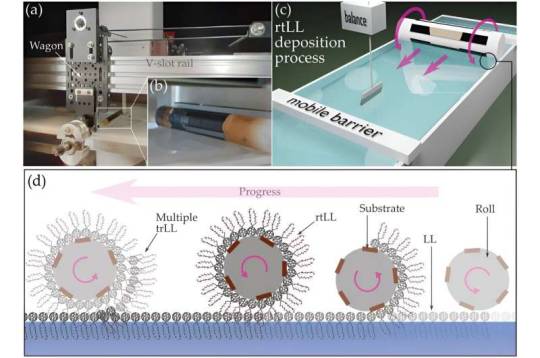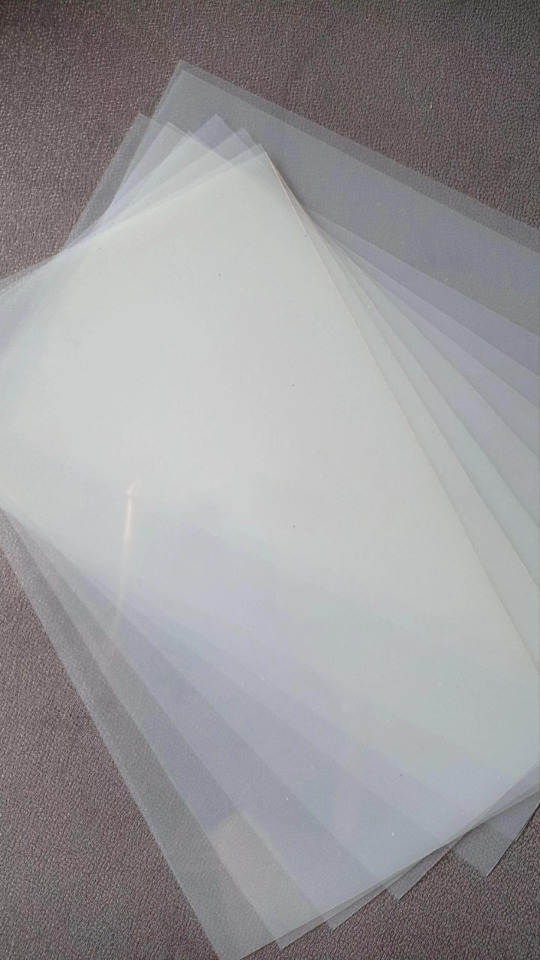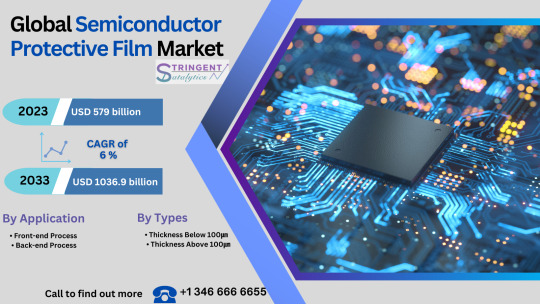#Semiconductor Film
Text
Semiconductor Film Market

0 notes
Text

Researchers develop new method for manufacturing tailor-made semiconductor thin films
Organic semiconductor materials are promising key technologies for the development of state-of-the-art optoelectronic components and are used in photovoltaics as well as in sensor technology and microelectronics. In order to produce thin organic semiconductor films automatically and with well-defined properties, researchers—led by Leibniz IPHT in Jena, Germany—have developed a new technological approach for depositing thin films with high molecular precision.
The method for manufacturing thin films with tailor-made electronic properties is presented in the journal Advanced Materials.
Organic semiconductors, which usually consist of carbon-based molecular materials or polymers, are part of a variety of today's applications: For example, ultra-thin, mechanically flexible and lightweight semiconductor thin films are used in modern transistors, sensitive sensors, or organic solar cells. Their energy conversion potential and thus their functionality is determined by the electronic energy levels of the organic thin films, which depend on the molecules as well as their arrangement and the interactions between neighboring molecules within the thin films.
Read more.
#Materials Science#Science#Thin films#Semiconductors#Manufacturing#Materials processing#Organic materials
10 notes
·
View notes
Text
Ethylene-tetrafluoroethylene copolymer
ETFE film is a hot melt extrusion cast film made of ETFE resin (ethylene-tetrafluoroethylene copolymer). ETFE films provide all the excellent properties of fluorine element films, such as being heat weldable, thermoformable, and easy to compound with other materials. ETFE films are ideal release materials for construction, solar and composite materials. Please contact me for a quote if required.
Henan Six Fluorochemical Co., Ltd
WhatsApp/Telegram:+(86)15038852660


0 notes
Text

Advanced Sputtering System by Blue Wave Semi
Explore the cutting-edge BWS sputtering system from Blue Wave Semi. Our advanced technology ensures precise thin film deposition for a range of applications. Transform your research and development with our reliable and innovative sputtering solutions.
0 notes
Text
0 notes
Text
Global Optical Coatings Market to Grow at a CAGR of 10.8% during Forecast Period
Global optical coatings market is growing at a high CAGR because of the increasing demand for thin-film optical coating in semiconductor, scientific, solar, and military equipment. The market is also getting driven due to growth in automotive and telecommunication sectors which demands optical coatings.
A recent study conducted by the strategic consulting and market research firm, BlueWeave Consulting, revealed that the global optical coatings market was worth USD 13.58 billion in the year 2021. The market is projected to grow at a CAGR of 10.8% from 2022-2028 (forecast period), earning revenues of around USD 28.21 billion by the end of 2028.

The global optical coatings market is booming because of the rising demand for thin-film optical coating in semiconductor, scientific, solar, and military equipment. With increasing demand of automotives and telecommunications there has been an exponential rise in optical coatings market.
Nano-scale optical coatings capture 20% more sunlight than untreated solar panels and minimize production costs
Renewable sources of energy, such as solar, wind, and hydro, are at the top of the list when it comes to the realization that nations all over the world are coming to terms with the necessity of diversifying their energy portfolios. Solar panels frequently make use of nano-scale optical coatings and other types of optical coatings because these coatings can increase the efficiency of solar cells by up to twenty percent when compared to uncoated solar panels and help manufacturers reduce their expenses.
In addition, the global optical coatings market is expected to develop at a healthy rate throughout the projected period, primarily due to rising demand from end use sectors such as consumer electronics and healthcare. Electronic displays are an integral part of a variety of medical devices. Due to the vital nature of seeing and monitoring clinical and diagnostic data, these displays are deployed with optical coatings to enhance display viewing quality.
Request for Sample Report @ https://www.blueweaveconsulting.com/report/optical-coatings-market/report-sample
Challenge
Price volatility and scattered availability of raw materials to hinder market growth
Optical coatings can be made from a variety of raw materials, including metallic oxides, metals, rare earth metals, and fluoride compounds. These are all employed in the manufacturing process. Another major factor that is expected to limit the growth of the optical coatings market around the world is the stringent regulations concerning the application of other raw materials, such as chromic acid, which is commonly used for decorative and hard optical coatings. The concern for price volatility and scattered availability of these raw materials which includes rare earth metals too is also a challenge that is expected to limit the growth of the optical coatings market around the world.
Segment Coverage
Global Optical Coatings Market - By Application
On the basis of application, the global optical coatings market is divided into electronics and semiconductor, aerospace and defense, telecommunications, automotive and transportation, solar power, construction and infrastructure, healthcare, and others. By 2028, electronics and semiconductor segment to account for a considerable portion, on account of growth in consumer electronics sales. Rising demand for smartphones, touchscreens, optical add-on packages, displays, and product technologies are driving consumer electronics market. Automobile mirrors, panels, and dashboards are coated.
Global Optical Coatings Market – By Region
By region, the global optical coatings market has been categorized into North America, Europe, Asia Pacific, Latin America, and Middle East and Africa, wherein Asia Pacific is the leading market. Better economic conditions and considerable discretionary spending in middle-income countries make consumer electronics popular in the Asia Pacific region. Asia Pacific's top anti-reflective optical coatings markets include China, India, and South Korea. Thus, anti-reflective optical coatings in automotive sector expansion will strengthen the region's market, which dominates globally.
Impact of COVID-19 on Global Optical Coatings Market
Widespread COVID-19 stunted the optical coatings' market growth by the manufacturing sector's collapse. As a result of the pandemic's effects on major economies, production in industries of optical coatings has decreased. Due to the pandemic, there has been a decline in the number of sectors, like telecommunications, which requires optical coatings as well. Thus, COVID-19 has affected the global optical coatings market and has been a challenging phase in many sectors which require optical coatings like automotive and telecommunication.
Competitive Landscape
Some of the key players operating in the market include JENOPTIK, SCHOTT, Gelest Inc., Optimax Systems, Inc., Materion Corporation, DuPont, Nippon Electric Glass Co., Ltd., PPG Industries, Inc., Inrad Optics, VIAVI Solutions Inc. and other prominent players. Most organizations integrate raw material manufacturing and distribution to maintain product consistency and expand which lowers costs and increases profits. To maintain their supremacy, the market players are continuously taking steps to enhance their optical coating ways.
Don’t miss the business opportunity in the Global Optical Coatings market. Consult our analysts to gain crucial insights and facilitate your business growth.
The in-depth analysis of the report provides information about growth potential, upcoming trends, and statistics of the global optical coatings market. It also highlights the factors driving forecasts of total market size. The report promises to provide recent technology trends in the global optical coatings market and industry insights to help decision-makers make sound strategic decisions. Furthermore, the report also analyzes the growth drivers, challenges, and competitive dynamics of the market.
About Us
BlueWeave Consulting provides comprehensive Market Intelligence (MI) Solutions to businesses regarding various products and services online and offline. We offer all-inclusive market research reports by analyzing both qualitative and quantitative data to boost the performance of your business solutions. BWC has built its reputation from the scratch by delivering quality inputs and nourishing long-lasting relationships with its clients. We are one of the promising digital MI solutions companies providing agile assistance to make your business endeavors successful.
Contact Us:
BlueWeave Consulting & Research Pvt. Ltd
+1 866 658 6826 | +1 425 320 4776 | +44 1865 60 0662
0 notes
Link
In-depth Understanding of Semiconductor PI Film Industry
Industry analysis provides a company with an understanding of its position relative to other companies in the industry. This can help them identify opportunities and potential threats, so they can prepare for the present and future. MRI Research helps organizations to figure out whats happening in a given industry, including demand and supply statistics, degree of competition, state of competition with other emerging industries, future prospects considering technological changes, and external factors on the industry.
0 notes
Note
What are some of the coolest computer chips ever, in your opinion?
Hmm. There are a lot of chips, and a lot of different things you could call a Computer Chip. Here's a few that come to mind as "interesting" or "important", or, if I can figure out what that means, "cool".
If your favourite chip is not on here honestly it probably deserves to be and I either forgot or I classified it more under "general IC's" instead of "computer chips" (e.g. 555, LM, 4000, 7000 series chips, those last three each capable of filling a book on their own). The 6502 is not here because I do not know much about the 6502, I was neither an Apple nor a BBC Micro type of kid. I am also not 70 years old so as much as I love the DEC Alphas, I have never so much as breathed on one.
Disclaimer for writing this mostly out of my head and/or ass at one in the morning, do not use any of this as a source in an argument without checking.
Intel 3101
So I mean, obvious shout, the Intel 3101, a 64-bit chip from 1969, and Intel's first ever product. You may look at that, and go, "wow, 64-bit computing in 1969? That's really early" and I will laugh heartily and say no, that's not 64-bit computing, that is 64 bits of SRAM memory.


This one is cool because it's cute. Look at that. This thing was completely hand-designed by engineers drawing the shapes of transistor gates on sheets of overhead transparency and exposing pieces of crudely spun silicon to light in a """"cleanroom"""" that would cause most modern fab equipment to swoon like a delicate Victorian lady. Semiconductor manufacturing was maturing at this point but a fab still had more in common with a darkroom for film development than with the mega expensive building sized machines we use today.
As that link above notes, these things were really rough and tumble, and designs were being updated on the scale of weeks as Intel learned, well, how to make chips at an industrial scale. They weren't the first company to do this, in the 60's you could run a chip fab out of a sufficiently well sealed garage, but they were busy building the background that would lead to the next sixty years.
Lisp Chips
This is a family of utterly bullshit prototype processors that failed to be born in the whirlwind days of AI research in the 70's and 80's.
Lisps, a very old but exceedingly clever family of functional programming languages, were the language of choice for AI research at the time. Lisp compilers and interpreters had all sorts of tricks for compiling Lisp down to instructions, and also the hardware was frequently being built by the AI researchers themselves with explicit aims to run Lisp better.
The illogical conclusion of this was attempts to implement Lisp right in silicon, no translation layer.

Yeah, that is Sussman himself on this paper.
These never left labs, there have since been dozens of abortive attempts to make Lisp Chips happen because the idea is so extremely attractive to a certain kind of programmer, the most recent big one being a pile of weird designd aimed to run OpenGenera. I bet you there are no less than four members of r/lisp who have bought an Icestick FPGA in the past year with the explicit goal of writing their own Lisp Chip. It will fail, because this is a terrible idea, but damn if it isn't cool.
There were many more chips that bridged this gap, stuff designed by or for Symbolics (like the Ivory series of chips or the 3600) to go into their Lisp machines that exploited the up and coming fields of microcode optimization to improve Lisp performance, but sadly there are no known working true Lisp Chips in the wild.
Zilog Z80
Perhaps the most important chip that ever just kinda hung out. The Z80 was almost, almost the basis of The Future. The Z80 is bizzare. It is a software compatible clone of the Intel 8080, which is to say that it has the same instructions implemented in a completely different way.
This is, a strange choice, but it was the right one somehow because through the 80's and 90's practically every single piece of technology made in Japan contained at least one, maybe two Z80's even if there was no readily apparent reason why it should have one (or two). I will defer to Cathode Ray Dude here: What follows is a joke, but only barely

The Z80 is the basis of the MSX, the IBM PC of Japan, which was produced through a system of hardware and software licensing to third party manufacturers by Microsoft of Japan which was exactly as confusing as it sounds. The result is that the Z80, originally intended for embedded applications, ended up forming the basis of an entire alternate branch of the PC family tree.
It is important to note that the Z80 is boring. It is a normal-ass chip but it just so happens that it ended up being the focal point of like a dozen different industries all looking for a cheap, easy to program chip they could shove into Appliances.
Effectively everything that happened to the Intel 8080 happened to the Z80 and then some. Black market clones, reverse engineered Soviet compatibles, licensed second party manufacturers, hundreds of semi-compatible bastard half-sisters made by anyone with a fab, used in everything from toys to industrial machinery, still persisting to this day as an embedded processor that is probably powering something near you quietly and without much fuss. If you have one of those old TI-86 calculators, that's a Z80. Oh also a horrible hybrid Z80/8080 from Sharp powered the original Game Boy.
I was going to try and find a picture of a Z80 by just searching for it and look at this mess! There's so many of these things.

I mean the C/PM computers. The ZX Spectrum, I almost forgot that one! I can keep making this list go! So many bits of the Tech Explosion of the 80's and 90's are powered by the Z80. I was not joking when I said that you sometimes found more than one Z80 in a single computer because you might use one Z80 to run the computer and another Z80 to run a specialty peripheral like a video toaster or music synthesizer. Everyone imaginable has had their hand on the Z80 ball at some point in time or another. Z80 based devices probably launched several dozen hardware companies that persist to this day and I have no idea which ones because there were so goddamn many.
The Z80 eventually got super efficient due to process shrinks so it turns up in weird laptops and handhelds! Zilog and the Z80 persist to this day like some kind of crocodile beast, you can go to RS components and buy a brand new piece of Z80 silicon clocked at 20MHz. There's probably a couple in a car somewhere near you.
Pentium (P5 microarchitecture)
Yeah I am going to bring up the Hackers chip. The Pentium P5 series is currently remembered for being the chip that Acidburn geeks out over in Hackers (1995) instead of making out with her boyfriend, but it is actually noteworthy IMO for being one of the first mainstream chips to start pulling serious tricks on the system running it.

The P5 comes out swinging with like four or five tricks to get around the numerous problems with x86 and deploys them all at once. It has superscalar pipelining, it has a RISC microcode, it has branch prediction, it has a bunch of zany mathematical optimizations, none of these are new per se but this is the first time you're really seeing them all at once on a chip that was going into PC's.
Without these improvements it's possible Intel would have been beaten out by one of its competitors, maybe Power or SPARC or whatever you call the thing that runs on the Motorola 68k. Hell even MIPS could have beaten the ageing cancerous mistake that was x86. But by discovering the power of lying to the computer, Intel managed to speed up x86 by implementing it in a sensible instruction set in the background, allowing them to do all the same clever pipelining and optimization that was happening with RISC without having to give up their stranglehold on the desktop market. Without the P5 we live in a very, very different world from a computer hardware perspective.
From this falls many of the bizzare microcode execution bugs that plague modern computers, because when you're doing your optimization on the fly in chip with a second, smaller unix hidden inside your processor eventually you're not going to be cryptographically secure.
RISC is very clearly better for, most things. You can find papers stating this as far back as the 70's, when they start doing pipelining for the first time and are like "you know pipelining is a lot easier if you have a few small instructions instead of ten thousand massive ones.
x86 only persists to this day because Intel cemented their lead and they happened to use x86. True RISC cuts out the middleman of hyperoptimizing microcode on the chip, but if you can't do that because you've girlbossed too close to the sun as Intel had in the late 80's you have to do something.
The Future
This gets us to like the year 2000. I have more chips I find interesting or cool, although from here it's mostly microcontrollers in part because from here it gets pretty monotonous because Intel basically wins for a while. I might pick that up later. Also if this post gets any longer it'll be annoying to scroll past. Here is a sample from a post I have in my drafts since May:

I have some notes on the weirdo PowerPC stuff that shows up here it's mostly interesting because of where it goes, not what it is. A lot of it ends up in games consoles. Some of it goes into mainframes. There is some of it in space. Really got around, PowerPC did.
153 notes
·
View notes
Text
The problem with AI and the entertainment industry in particular is that...okay, fine, technology marches on. Digital art made physical ink-on-cels animation into mostly a hobbyist novelty (though boy howdy did it ever make it an impressive one). Photography turned portrait painting into a luxury, rather than something everyone who could afford it saved to do at least once for every family member because it was the only way to keep their likenesses alive. Photo editing has gone through so many changes that it's almost unrecognizable compared to what it looked like as recently as the 80s and 90s, and the older methods are, again, super impressive hobbyist passion projects now. Digital painting made physical painting less viable in an economy of scale, but way more impressive as an art form. These kinds of changes always really fucking suck for some people, but you can't really prevent them without stifling human development in general.
But.
The entertainment industry wants to make it suck way more than it has to for everyone but their executives and shareholders. They want to have their cake and eat it too. They want to take advantage of the inherent marketing power of celebrity culture without ACTUALLY involving, let alone paying, the people whose names and likenesses they're using. That, I hope we can all agree, is vile.
Now, the logical endpoint of this is that we push back against that, and as an alternative we get more fictional celebrities in the near-ish future, and as a Vocaloid fan, theoretically, I dont see much of a problem with that. Theoretically, at least. In the best case scenario, I think it could be a lot of fun! But the problem is, well...
See, in the early days, Vocaloid producers tended to take a very backstage role. Very few people were fans of specific producers; they were fans of Miku or any other character. Eventually, though, producers just kind of came more into the spotlight on their own because everyone has their own style and taste. We still love the characters, but we all started to notice when half our favorite songs by Miku were produced by the same person, well, perhaps we were fans of that producer as well!
But in American-born entertainment culture...
You may notice that CGI was conspicuously absent from my Technology Marches On breakdown. That's because while, yes, it has made for an interesting highlight of practical effects, with love for the work and nostalgia for their jank the same way other new art media has shone a spotlight on its predecessors, it hasn't actually gotten to be recognized as an art form the way the others listed have. We've barely moved on from the attitude that got Tron disqualified from the Academy Awards for SFX because "the computer did those effects, not you" (in 1982). In fact, I'm strongly of the belief that if Disney were a halfway decent company, they would be bragging about how they're pioneering photorealistic animation, rather than trying to pass off 90+% CGI animated films, usually (but not always; see: The Lion King remake) with live celebrity actors' faces composited in, as "live-action". Instead, they treat the VFX department as mindless dancing monkeys, and perpetuate the idea that VFX is just "select material, press button, get polished scene" - because to brag about it as its own art form might imply that the people doing it are skilled artists who deserve to be paid fairly and treated like human beings, and oh, we can't have THAT, now can we?
VFX labor is all hidden; very few people have a favorite VFX artist or director, instead we treat the artists, who put the time and effort into wrangling code and semiconductors and routines and layers into creating a professional-looking end product, as just part of the machine themselves, to save the companies some money - and culturally, I fear we're well on the way to regarding AI exactly the same way but worse.
As such, I fear that we wouldn't have the same effect with any digital idols produced by Silicon Valley.
Now, I don't fear virtual celebrities being able to fully replace human ones. Half of the draw of celebrity culture is the illusion of human connection. As much as the word "parasociality" has grown to be associated with only the negative effects of this, in reality, it's also the driving mechanism behind why representation matters. It's fun to be able to feel a connection to a fictional celebrity, but it doesn't replace the feeling of knowing that your fave is a human being with a real life - ...whether you use that knowledge for better or worse.
What I do fear is the fight against using AI to replicate real humans without their input, or with their manufactured consent, being long and drawn-out and doing a lot of harm before we can fully put a lock on it, and virtual celebrities being used to hide the work that the human directors and producers put into them for the sake of saving a parent company a buck.
26 notes
·
View notes
Text
Polymer-based electronics are much less energy-intensive to fabricate than current electronics, and are easy to scale up for production. Since polymer semiconductors are printable – they can be printed in the same way newspapers are – they would be ideal for portable, flexible and stretchable applications ranging from solar cells to new forms of computers.
#nanotechnology#materialsscience#electronics#printing#polymers#semiconductor#spintronics#scienceandtechnology
10 notes
·
View notes
Text
Semiconductor Protective Film Market

0 notes
Photo

Researchers find a way to reduce the overheating of semiconductor devices
The demand to shrink the size of semiconductors coupled with the problem of the heat generated at the hot spots of the devices not being effectively dispersed has negatively affected the reliability and durability of modern devices. Existing thermal management technologies have not been up to the task. Thus, the discovery of a new way of dispersing heat by using surface waves generated on the thin metal films over the substrate is an important breakthrough.
KAIST announced that Professor Bong Jae Lee's research team in the Department of Mechanical Engineering succeeded in measuring a newly observed transference of heat induced by "surface plasmon polariton" in a thin metal film deposited on a substrate for the first time in the world.
Surface plasmon polariton (SPP) refers to a surface wave formed on the surface of a metal as a result of strong interaction between the electromagnetic field at the interface between the dielectric and the metal and the free electrons on the metal surface and similar collectively vibrating particles.
Read more.
#Materials Science#Science#Semiconductors#Heat flow#Temperature#Surfaces#Thin films#Metals#Plasmons#Polaritons#Thermal conductivity#KAIST
21 notes
·
View notes
Text

Meet Lumi!
Lead operator over glass film manufacturing at a zedconian semiconductor plant.
She's kindhearted, innocent, and sweet. Easy to make laugh.
Manufactured in February 1991, she is a very late-model zedconian. She has has a light, off-white paint scheme.
7 notes
·
View notes
Text

Expert Thin Film Coating Deposition Services by Blue Wave Semiconductors
Discover excellent thin film coating deposition services at Blue Wave Semiconductors. Our knowledge in deposition technologies guarantees top-quality coatings for different materials.
Count on us for accuracy, dependability, and advanced thin film solutions customized to your requirements.
0 notes
Text
Global Thin film Solar Cell Market Is Estimated To Witness High Growth Owing To Increasing Adoption of Renewable Energy Sources

The global Thin film Solar Cell Market is estimated to be valued at US$ 33.01 Bn in 2022 and is expected to exhibit a CAGR of 19.4% over the forecast period 2023-2030, as highlighted in a new report published by Coherent Market Insights.
A) Market Overview:
Thin film solar cells are made from semiconductor materials that convert sunlight into electrical energy. These solar cells offer various advantages such as flexibility, lightweight, and superior aesthetics compared to traditional solar panels. The need for clean and sustainable energy sources is driving the demand for thin film solar cells as they provide an efficient way to generate electricity from the sun. With the increasing focus on reducing carbon emissions and combating climate change, the demand for renewable energy sources like thin film solar cells is expected to witness significant growth.
B) Market Key Trends:
One key trend in the thin film solar cell market is the increasing investment in research and development activities to enhance the efficiency of these solar cells. Researchers and manufacturers are investing in developing new materials and technologies to improve the conversion efficiency of thin film solar cells. For example, Oxford Photovoltaics, one of the key players in the market, is developing perovskite-based solar cells that have shown promising results in terms of efficiency and cost-effectiveness. This trend is driving innovation in the market and is expected to lead to the commercialization of more efficient thin film solar cell products.
C) PEST Analysis:
Political: Governments around the world are implementing favorable policies and incentives to promote the adoption of renewable energy sources. This is creating a conducive environment for the growth of the thin film solar cell market.
Economic: The declining cost of thin film solar cells, coupled with the increasing demand for clean energy, is driving the economic feasibility of these solar cells. This is attracting investments from both government and private entities.
Social: The increasing awareness about the environmental impact of traditional energy sources is driving the social acceptance and demand for renewable energy solutions like thin film solar cells. Additionally, the aesthetics and design flexibility offered by these solar cells are appealing to consumers.
Technological: Advances in thin film solar cell technologies are improving their efficiency and performance. New materials and manufacturing processes are being developed, leading to the commercialization of more efficient and cost-effective products.
D) Key Takeaways:
Paragraph 1: The Global Thin Film Solar Cell Market Demand is expected to witness high growth, exhibiting a CAGR of 19.4% over the forecast period, due to increasing adoption of renewable energy sources. The need for clean and sustainable energy solutions is driving the demand for thin film solar cells.
Paragraph 2: The Asia Pacific region is expected to dominate the thin film solar cell market, with countries like China, India, and Japan leading the way in terms of installation and production capacity. The region's favorable government policies, abundant solar resources, and growing energy demand are contributing to its fast-paced growth in the market.
Paragraph 3: Key players operating in the global thin film solar cell market are Ascent Solar Technologies, Inc., FIRST SOLAR, Kaneka Corporation, MiaSolé Hi-Tech Corp., and Oxford Photovoltaics. These companies are investing in research and development activities to improve the efficiency and performance of their thin film solar cell products. They are also focusing on strategic collaborations, partnerships, and mergers and acquisitions to expand their market presence.
#Thin Film Solar Cell Market#Thin Film Solar Cell Market Demand#Solar Cells#Thin Film Solar Cell Market GRowth#Thin Film Solar Cell Market Trends#Coherent Market Insights
3 notes
·
View notes